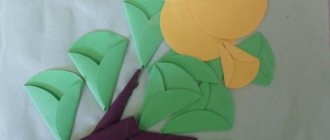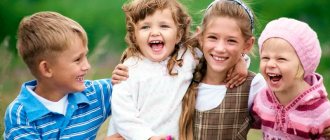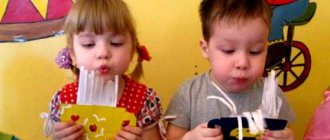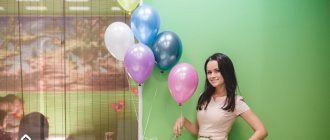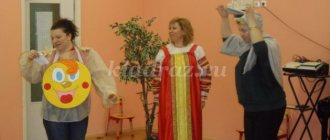Senior group. Senior preschool age. Children 5-6 years old
Program of an environmental and local history club for children 5–6 years old Additional general education general development program of an environmental and local history focus “My Roots”
for
children 5–6 years old 1 . EXPLANATORY NOTE Focus of the program : This program is implemented within the framework of the social and personal development of a preschooler, takes into account.
Additional general education program “Entertaining Mathematics” in the senior group Additional general education program – additional general development program for preschool “Entertaining Mathematics”
aimed at developing cognitive interests and intellectual development
of children .
Explanatory note In the process of training and education. Publication “Work program of the circle “Entertaining Mathematics” (middle group. » WORK PROGRAM OF THE CIRCLE “ENTERTAINING MATHEMATICS” (middle group 4-5 years old) Explanatory note The formation and development of mathematical concepts in preschoolers is the basis of the intellectual development of children, contributes to general mental education .
Work program of the plasticineography circle “Plasticine Miracles” for senior, preparatory groups Explanatory note Scientists have identified a connection between the active movement of a child’s fingers and the formation of his speech apparatus. A child learns about the world through manipulation, that is, actions with various objects that allow him to recognize and study their properties. Development.
Additional general education program for the development of fine motor skills “The Magic World of Creativity” for children 5–6 years old Additional general education program for the development of fine motor skills “The Magic World of Creativity” for children 5–6 years old. Program for the development of fine motor skills “Nimble Fingers” for children 5-6 years old. A circle program for the development of fine motor skills “Nimble Fingers” for children 5-6 years old.
Article “Additional general education program for the development of small children. » Additional general educational program for the development of fine motor skills “The Magical World of Creativity” for children 4–5 years old. Fine motor skills development program “Nimble Fingers” for children 4–5 years old. A circle program for the development of fine motor skills “Nimble Fingers” for children 4–5 years old.
Work program of the theater club “Fairy Tale” for children 4–6 years old, Part 2 Educational and thematic plan First year of study. Training at the first stage involves developing children's interest in musical and theatrical art; acquaintance with the basics of theatrical art; mastery of the conceptual apparatus. Much attention is paid to work on.
Work program of the theater club “Fairy Tale” for children 4–6 years old, part 1 Explanatory note Theatrical activities are an organic synthesis of fiction, music, dance, acting and concentrate the means of expression, contribute to the development of aesthetic perception of the surrounding world, children.
Source
Tasks of circle work
The tasks of general development circles, first of all, depend on the educational field and type of activity chosen by the teacher. The goals and objectives of the circle work are indicated in the circle program: general - in the target part, specific - in the work plan for each lesson separately.
Table: planning the work of the “School for Young Book Lover” circle, developed by A. N. Pimenova
| Purpose of the program |
| |
| Program objectives |
| |
| Methods of working with the book |
| |
| Long-term work plan for the circle (fragment) | ||
| Month | Lesson topic | Lesson objectives |
| September | "Excursion to the children's library." Getting to know the reading room, the librarian, and his work. | Find out how books live, arouse interest in them. |
| Conversation "Her Majesty's Book". | Arouse interest in reading fiction. Reveal the role of books in people's lives, show the importance of books and reading for the formation of children's intellectual and creative abilities. | |
| Conversation “The fairy tale is rich in wisdom.” Reading the Russian folk tale “Sister Alyonushka and Brother Ivanushka” | Introduce children to the variety of Russian folk tales. Enrich children's reading experience with works of a more complex genre (fairy tales). Provide the ability to tell a fairy tale from the perspective of a literary character. | |
| Getting to know the works of A.S. Pushkin. Reading poems about autumn. | Introduce children to the biography and work of the poet. Cultivate sensitivity to the artistic word. Arouse interest in the poet’s work, a desire to listen to his works. | |
| October | Conversation “Where the book came from” | Give a basic idea of how books are created. |
| Group visit to the mini-museum of books. Excursion “Books of our grandmothers”. | Give children an idea of what books looked like in the last century, what kind of illustrations they had. | |
| Competition "Let's bring our fairy tales to life." | Learn to note the features of a fairy tale, understand the motives of the heroes’ actions, learn to transform, developing intonation expressiveness. | |
| Acquaintance with the work of N. Nosov. Reading the story “The Living Hat.” | Introduce children to the work of the writer N. Nosov. Contribute to the formation of an emotional attitude towards a literary work. | |
| November | Celebration of “Dedication to Readers”. | To help little listeners become readers, to instill interest, love, and respect for the book as a source of new interesting information. |
| "Journey through the Russian Fair" | Introduce children to various genres of oral folk art. Arouse interest in folklore. | |
| Acquaintance with the work of Yu. Vasnetsov. Productive activity: drawing “Favorite fairy tale characters.” | Expand your understanding of the work of an artist - an illustrator of children's books. | |
| “Miracle Tree” - quiz. | Consolidate knowledge about the works of K.I. Chukovsky. | |
| Quote By: | https://nsportal.ru/detskiy-sad/raznoe/2015/03/30/programma-kruzhka-dlya-detey-starshey-gruppy-detskogo-sada-shkola | |
Senior group. Senior preschool age. Children 5-6 years old
Group work program “Young Wizards” for children of senior preschool age Group work program “Young Wizards”
(non-traditional drawing technique)
Senior group
“Colored Palms”
teacher: Khaziakhmetova O.D. The problem of developing children's creativity is currently one of the most pressing problems, because we are talking about the most important thing.
Additional education program “Magic with your own hands” in the senior group ADDITIONAL EDUCATION PROGRAM “MAGIC WITH YOUR OWN HANDS”
senior group “The origins of
children’s are at their fingertips. From the fingers, figuratively speaking , come the finest streams that feed the source of creative thought. The more confidence and...
Circle work. Club programs, work programs for additional education for children
The materials in this thematic section will help in the development and execution of work programs in the system of additional education for children. These pages contain ready-made programs for clubs of various types. These materials are often provided with comments from teachers about their direct application in practice. Each of the publications represents a developed additional educational course in a specific area. Including: experimental, artistic and aesthetic, local history and environmental, physical education and valeology.
Create only excellent work programs, using the positive experience of your colleagues.
Publication “Classes for the circle work program as part of implementation. » Topic: “Autumn Pictures” Purpose: To teach children to create plot compositions, to cultivate a desire to preserve the beauty of nature. Develop fine motor skills of the hands. Material: Leaves of shrubs, herbs, flower petals, seeds, colored cardboard, glue, tassels, napkins, oilcloths, options.
Group work program as part of the implementation of the pedagogical technology “Club Hour” “Little Craftsmen” Group work program as part of the implementation of the pedagogical technology “Club Hour” “Little Craftsmen” Author: Manuilova M.N. Divnogorsk, 2020 Relevance Artistic manual labor is the creative work of a child with various materials, in the process of which he creates.
Additional education program “The Magic World of Origami” Additional general education general development program of artistic orientation “Country of Origami” Age of students 5-7 years Duration of training 2 years Compiled by: Mashkova Tatyana Sergeevna teacher of the first qualification category, Moscow 2021 Contents I.
Program of the “Why” circle Explanatory note Childhood is an amazing and unique time. Everything is possible in it: the most boring and uninteresting things can turn out to be fun and entertaining. We want our students to be independent, inquisitive, sociable, and able to navigate their environment.
Group work program “Funny Undertakings” work program (senior group) on the topic
Municipal budgetary preschool educational institution
city of Kostroma "Kindergarten No. 80"
| The program was reviewed and approved at a meeting of the pedagogical council Protocol No. ____dated “____”_____20__ I CONFIRM: Head of the kindergarten ____________ N.P. Vasilyeva |
WORK PROGRAM OF CLUB WORK
FOR CHILDREN OF SENIOR PRESCHOOL AGE
"FUN THINGS"
The program was developed by Svetlana Sergeevna Golysheva, (educator I quarter category by position
teacher, leader of the "Entertainers" club)
Kostroma 2013
If I want it, the cat will be blue, And there will be triangular clouds in the sky, And instead of eyes I will draw two windows, And the house will have a floor instead of a ceiling!
Let the snow swirl now in June, And it becomes hot in December, Let the people of the whole planet be friends, And peace come on earth!
Explanatory note
Preschool age is the foundation of a child’s overall development, the starting period of all high human principles. It is at this age that the foundations for the comprehensive, harmonious development of the child are laid.
Fine creativity is a specific children’s activity aimed at the aesthetic exploration of the world through the visual arts, the most accessible form of a child’s knowledge of the world. The most characteristic feature of the aesthetic attitude of a small child is the immediacy of the interested, evaluating “I” from any objective situation; the inseparability of emotions from the processes of perception, thinking and imagination. We can assert that artistic creativity has the most direct influence on the development of children’s aesthetic attitude to reality.
The ability to be creative is a distinctive feature of man, thanks to which he can live in unity with nature, create without causing harm, multiply without destroying. Psychologists and teachers have come to the conclusion that the early development of creativity, already in preschool childhood, is the key to future success.
The formation of a creative personality is one of the important tasks of pedagogical theory and practice at the present stage. Today our society needs non-standard, diversified individuals. We need not only knowledgeable people, but also people capable of creative activity. Achieving this goal is impossible without implementing the tasks facing the educational field “Artistic Creativity”, an integral part of which is fine art.
The development of the creative abilities of a preschooler is given sufficient attention in such comprehensive programs as: “Childhood”, “Rainbow”, “Development”, etc. The authors of new generation programs propose, through the section of artistic and aesthetic education, to introduce children to traditional methods of drawing. Thus developing the child’s creative abilities.
The lack of development of graphic skills and abilities prevents the child from expressing his plans in drawings, adequately depicting objects of the objective world, and complicates the development of cognition and aesthetic perception. Fine art has a variety of materials and techniques. Often, familiar, traditional ways and means are not enough for a child to express his fantasies.
Having analyzed the author's developments, various materials, as well as advanced experience in working with children, accumulated at the present stage by domestic and foreign teaching practitioners, I became interested in the possibility of using non-traditional art techniques in working with preschoolers to develop imagination, creative thinking and creative activity. Unconventional painting techniques demonstrate unusual combinations of materials and tools. Undoubtedly, the advantage of such techniques is the versatility of their use. The technology for their implementation is interesting and accessible to both adults and children. That is why non-traditional methods are very attractive for children, as they open up great opportunities for expressing their own fantasies, desires and self-expression in general.
Thus, the constant search for new forms and methods of organizing the educational and educational process allows us to make work with children more diverse, emotional and information-rich. The availability of material for group work, its high quality, and a variety of drawing methods will help the child see and convey on paper what is much more difficult to do using conventional methods.
For this purpose, a circle was created
Relevance. Activities in the circle allow children to develop not only artistic abilities, but also communication skills in the process of working with non-traditional materials.
Target:
To develop the potential abilities inherent in the child, interest in their own discoveries through search activities.
This program helps solve the following problems:
Educational:
— Form creative thinking, sustainable interest in artistic activity;
-Develop artistic taste, imagination, ingenuity, spatial imagination.
— To develop the skills and abilities necessary to create creative works.
— Develop a desire to experiment, showing vivid cognitive feelings: surprise, doubt, joy from learning new things.
Educational:
— To consolidate and enrich children’s knowledge about different types of artistic creativity.
— To introduce children to various types of visual arts, the variety of artistic materials and techniques for working with them, to consolidate acquired skills and abilities and to show children the breadth of their possible application.
Educational:
— Cultivate hard work and the desire to achieve success through one’s own labor.
— Cultivate attention, accuracy, determination, creativity
self-realization.
The program is designed for children of senior preschool age. Classes take place in the afternoon twice a week.
In our work we are guided by the following principles:
- Scientific principle
- The principle of individualization and differentiated approach:
- The principle of the optimal combination of visual, verbal and practical teaching methods.
- The principle of gradually increasing requirements.
- Own principles:
— Approach the child only from a position of support, not error (“You will succeed”);
— Position towards the child (be together, always come to the rescue);
- Looking “through the eyes of a child” - putting yourself in the child’s place;
In the process of work, the integration of all educational areas is ensured:
Cognition: artistic creativity games, composition modeling games.
Reading fiction: poems and stories about nature.
Socialization: solving problem situations, developing friendly relationships.
Communication: developing the ability to maintain a conversation, generalize, draw conclusions, express your point of view.
Physical education and Health: the use of physical exercises, finger exercises, work to protect vision and prevent poor posture. Music: the use of musical works to enrich the content of the area, the development of children's creativity, introduction to various types of art.
Labor: cultivate a desire to participate in joint work activities, careful attitude to materials and tools;
Techniques and methods used in the circle classes:
- Emotional mood - the use of musical works,
- Practical – exercises, game methods,
- Verbal methods - stories, conversations, artistic expression, pedagogical dramatization, verbal techniques - explanation, clarification, pedagogical assessment.
- Visual methods and techniques - observations, examination, showing a sample, showing methods of implementation, etc.
All methods are used in combination.
Reporting forms for the implementation of the work program:
- Organizing monthly exhibitions of children's works for parents.
- Thematic exhibitions in preschool educational institutions.
- Participation in city and exhibitions and competitions throughout the year.
- Creative report of the teacher - the leader of the circle.
- Design of an aesthetic development environment in the group. Etc.
Expected result:
- Children will learn safety rules while working.
- Children will be able to create stories and images and combine them into collective compositions.
- They will master the technique of drawing in unconventional ways, various appliqué techniques.
- Children will show improvements in fine motor skills of their fingers, the ability to navigate on a plane, and, as a result, improved speech activity.
Assessment: the effectiveness of the program is carried out twice a year (December, May) to determine the level of artistic and aesthetic development of children.
Working with parents.
The connection between family and teacher is built on trust. And mutual trust is a result of effective information exchange. To achieve this, we plan to work with parents clearly and clearly. To educate parents and convey the necessary information on a particular issue, we use different forms: individual and subgroup consultations, information sheets, memo sheets, folders.
In order to involve parents and children in a common interesting activity that involves direct communication between adults and children, exhibitions of crafts and creative works are organized.
Parent meetings will be held in different forms: round table, parent reception, etc. This activates parents, involving them in conversation, discussions, and disputes.
Annex 1
Long-term work plan for the circle.
| Month | Lesson topic | Target | Materials and equipment |
| October | 1.Magic wand. | Introduce children to the club premises; consider different types of materials for classes; develop an interest in working with different types of materials. | Album with samples of materials; old felt-tip pen, thread, PVA glue, cardboard, glitter for drawing. |
| 2. Little white bunny. | Teach children to carefully spread the drawing along the contour with glue and fill the drawing with material. | Bunny drawing blank, glue, brush, cotton wool, gouache. | |
| 3. Autumn forest. | Introduce children to the technique of making prints with dry leaves, teach them how to apply paint to leaves and complete the drawings. | A sheet of paper for the background, dry leaves, gouache, brushes. | |
| 4.Octopus from the palm. | Teach children to use in their work on the palm printing technique; learn to select the necessary color scheme. | Gouache, brushes, sheets of paper. | |
| november | 1.Magic bubbles. | Show children the possibility of drawing on the entire surface of a sheet in one movement, teach them to be careful in this type of work. | Watercolor paints, dishwashing liquid, water tray, straw, sheet of paper. |
| 2.White swans. | Teach children to draw with their whole palm, to complete what they receive in accordance with what was planned. | White gouache, watercolor paints, brushes. | |
| 3.Underwater world. | Teach children the technique of plasticineography, teach them to use a stencil in their work, and instill in children accuracy in working with bulk materials. | Plasticine, fish stencils, a sheet of blue cardboard for the background, a simple pencil, glue, corn or millet grits. | |
| 4.Mushrooms. | Train children in the ability to paint three-dimensional shapes, teach them to connect parts using plasticine to create a familiar image. | Caps from felt-tip pens, cardboard egg cells (cut one at a time), plasticine for fastening, watercolor/gouache paints, brushes. | |
| December | 1.Frosty patterns. | Teach children how to draw frosty patterns, teach them how to apply glue to the necessary areas and fill them with cereal, and decorate their work with glitter. | Sheets of purple cardboard in the shape of a window, sample patterns, a simple pencil, semolina, glitter for drawing, glue. |
| 2. Herringbone-green needle. | Teach children how to cut out a sheet of paper folded in half, introduce them to the concept of symmetry, and decorate the work as desired. | A sheet of colored cardboard for the background, colored paper, sequins, beads, plasticine, cotton wool, glue, scissors. | |
| 3. Mittens for the Snow Maiden. | Train children in the ability to fill a finished mold with plasticine and decorate the finished one. | Mitten stencil, plasticine, stack, simple pencil, beads, tinsel, sequins. | |
| 4.Penguin. | Teach how to create the image of a familiar animal, develop children’s ability to work with napkins, strengthen the ability to cut parts with scissors, and enjoy the result. | Penguin template, white napkins, eye and nose details, glue, scissors. | |
| January | 1. House for the Snow Maiden. | To develop children's ability to cut out figures from paper, stick them on a background sheet, decorate them with patterns to create a fairy-tale image. | Blanks for cutting, cotton wool, glitter, scissors, glue, background sheet. |
| 2. Box for pencils. | Introduce children to the decoupage technique, teach them to be careful when working, and to work carefully with a napkin. | Milk carton cut in half, glue, brush, decoupage napkins, scissors, glitter, acrylic varnish. | |
| 3. Saucer with a blue border (stage 1). | Continue working using the decoupage technique; learn to work in several stages; Show the children the technique of decorating with eggshells. | Plastic plate, acrylic paint, eggshell, glue. | |
| 4. Saucer with a blue border (stage 2). | Teach children to separate the layer with the pattern from the napkin and carefully glue it to the surface of the plate. | Prepared plate, napkins for decoupage, glue, brushes, acrylic varnish. | |
| February | 1.Frosty patterns (2). | Introduce children to the technique of using salt in art; develop children's creativity and imagination. | Landscape sheet, watercolor paints, brushes, salt (coarse). |
| 2. Merry horse. | Teach children to draw animals step by step, combine drawing and applique skills in their work; instill in children a love of beauty and develop aesthetic taste. | White cardboard, pencil, colored pencils, thread, colored paper, scissors, glue. | |
| 3.Winter landscape. | To develop in children the ability to draw a landscape, to use the proposed materials in their work, and to teach them to draw trees. | A sheet of paper, gouache, foam rubber, brushes, cotton swabs, cereal, cotton wool, glue, glitter. | |
| 4. Christmas tree under the snow. | Introduce children to the technique of symmetrical drawing, teach them to carefully fold a sheet in half and draw only on one half of the sheet; practice finger painting using the poking method. | Sheet of paper, gouache. | |
| March | 1.Bouquet of roses. | Introduce the technique of drawing with threads: learn to carefully lay out a pattern of dyed threads, cover them with a second sheet and carefully pull them out, supplement your drawing with the necessary elements. | Two sheets of paper, thread, gouache, brushes. |
| 2.Bracelet (1st stage). | Introduce children to the technique of modeling from salt dough; talk about the properties of the dough; develop the ability to make holes in beads, develop imagination in inventing bead shapes. | Salt dough (different colors), toothpick. | |
| 3.Bracelet (2nd stage). | Teach children to assemble ready-made beads into a bracelet by threading a thread through the holes of the beads. | Spandex thread, prepared beads. | |
| 4.Bouquet of poppies. | Train children to combine applique and drawing in their work: consolidate the ability to draw a background with foam rubber and use the resulting background for applique. | Foam rubber, paints, poppy petals and red napkins, millet for the middle of the flower, brushes. | |
| April | 1.Flower tree. | Teach children to create collective compositions; continue teaching how to color three-dimensional shapes, thread a thread through a hole, and make a center out of a napkin; develop aesthetic taste. | Egg cells, cut one at a time, with a decorated carved edge, colored napkins, paints, brushes, glitter, glue, a branch prepared in advance, threads for attaching flowers to the branch. |
| 2.Ladybug. | Introduce children to a new type of material and use it in their work; learn to carefully paint a cotton base, develop the ability to create a finished composition. | Cotton pads, blank leaf, green threads, paints, brushes, glue. | |
| 3. Fun construction (stage 1). | Teach children the features of coloring polystyrene foam. | Polystyrene foam in the form of small bricks and parts for the roof, gouache, brushes. | |
| 4. Fun construction (stage 2). | Teach children how to design from the prepared material: lay out the parts along the contour and glue them, observing the sequence; decorate the house with the necessary elements. | Cardboard house template, prepared “bricks”, glue, paints, brushes. | |
| May | 1.Flower meadow. | Introduce children to the technique of making fabric appliqué. | Flower details made from fabric of different colors, cardboard for the background, glue, brushes. |
| 2. Miracle mnuchka. | Teach children to work with unusual materials to create toys. | Balloon, starch, spoon, thread, markers. | |
| 3. Fun magnets. | Teach children to make decorative magnets, decorate them to their liking, and develop aesthetic taste. | Element of a photograph (4*4) or picture, magnet, glue, glitter, sequins. | |
| 4.Fluffies. | Teach children to work with fragile materials, be careful and attentive, and develop their imagination. | Balloon, cotton wool, paints, glue, brushes. | |
The work program is focused on the use of the educational and methodological complex:
Literature:
1. Galanov A.S., Kornilova S.N., Kulikova S.L. Classes in fine arts for preschoolers. – M: Sphere shopping center, 2000. – 80 p.
2. Belkina V.N., Vasilyeva N.N., Elkina N.V. Preschooler: learning and development. To educators and parents. – Yaroslavl: “Academy of Development”, “Academy K˚”, 1998. – 256 p.
3. Fateeva A.A. We draw without a brush. – Yaroslavl: Academy of Development, 2006. – 96 p.
4. Coll, Mary Ann F. Drawing with paints. – M: AST: Astrel, 2005. – 63 p.
5. Collective creativity of preschool children: lesson notes./Ed. Gribovskoy A.A. – M: Sphere shopping center, 2005. – 192 p.
6. Solomennikova O.A. The joy of creativity. Development of artistic creativity in children aged 5-7 years. – Moscow, 2001.
7. Doronova T.N. Visual activity and aesthetic development of preschool children: a methodological manual for teachers of preschool educational institutions. – M. Education, 2006. – 192 p.
8. Dubrovskaya N.V. An invitation to creativity. – St. Petersburg: “Childhood Press”, 2004. – 128 p.
9. Casanova R.G., Sayganova T.I., Sedova E.M. Drawing with preschool children: Non-traditional techniques, planning, lesson notes. – M: Sphere shopping center, 2004 – 128 p.
10. Alekseevskaya N.A. Naughty pencil. – M: “List”, 1998. – 144 p.
11. Utrobina K.K., Utrobin G.F. Fascinating drawing using the poke method with children 3-7 years old: Draw and learn about the world around us. – M: Publishing house “GNOM and D”, 2001. – 64 p.
12. Lykova I.A. Visual activities in kindergarten. – M: “Karapuz – Didactics”, 2006. – 108 p.
I.A.Lykova “Artistic work in kindergarten. Ecoplastics";
20. Nikitina A.V. Unconventional drawing techniques in kindergarten. – St. Petersburg: KARO, 2007. – 96 p.
21. Miklyaeva N.V. Commented drawing in kindergarten. – M.: TC Sfera, 2010. – 128 p.
22. Komarova T.S. “Art activities in kindergarten”, Moscow, publishing house “Mosaika-Sintez”, 2006.
23. “Methodological recommendations for the program of education and training in kindergarten,” edited by M.A. Vasilyeva.
Technologies:
- Club program for non-traditional drawing techniques at a preschool educational institution. Author Filatova Svetlana Vladimirovna/https://nsportal.ru/detskii-sad/risovanie/programma-kruzhka-po-netradicionnoy-tehnike-risovaniya-v-dou. (experience exchange)
- WORK PROGRAM for the “Drawing” circle for preschool children aged 5-6 years. author Koldina N.I./ https://inyakino-sad.ru/programmy-v-dou/rabochaya-programma-po-kruzhku-risovalki/ (exchange of experience)
- T.N. Davydov “Drawing with palms”
- G.N. Davydova “Non-traditional drawing techniques in kindergarten” - M. 2007.
- G.N. Davydov “Crafts from waste material”;
- R.G. Kazakova “Drawing with preschool children. Non-traditional techniques";
- G.N. Davydov “Crafts from matchboxes”;
- N.G. Pishchikova “Working with paper in non-traditional techniques (parts 1, 2, 3)”;
- M.I.Nagibina “Miracles for children from unnecessary things”;
- G.N. Davydov “Plasticineography”;
- L.M. Evstratova “Flowers made of fabric, paper, wool, leather, beads, feathers, shells”;
- L.V. Kulikova “Funny plastic toys.”
